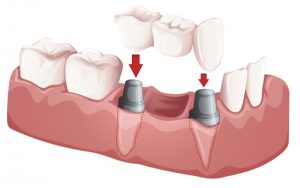Why Dental Implants Might Be Right For You
Losing teeth is a big problem because this can be caused for multiple issues like tooth decay that needs to be solved as soon as possible before the majority of the tooth gets lost, or even from other issues/infections that could harm the integrity of your other healthy teeth, for that reason, it will be better to remove that tooth that is causing the problem before the situation gets worse, but how would you replace that damaged tooth?
Well, the answer is kind of easy, with the help of dental implants everything will be easier for you and the Denver CO dentist to handle since with surgery you can have that tooth replaced with an artificial implant, but what is this implant all about? Let’s discover it right now
What are Dental Implants?
In a simple way of explaining it, dental implants are no more than titanium cylinders in form of a screw that will be inserted in your jawbone and gums to, later on, put a crown that will be the one that counts with the form of the artificial tooth.
 Often, people tend to misunderstand both terms, dental implants and crowns are not the same things, the implants will be those cylinders that will allow the jawbone, gums, and crown to work properly without suffering from any pain or secondary effect after the surgery, and the crown is that metallic part that will be inserted on top of the cylinder to look and act like a traditional tooth.
Often, people tend to misunderstand both terms, dental implants and crowns are not the same things, the implants will be those cylinders that will allow the jawbone, gums, and crown to work properly without suffering from any pain or secondary effect after the surgery, and the crown is that metallic part that will be inserted on top of the cylinder to look and act like a traditional tooth.
Which People are Suited for Dental Implants?
Sadly, not everyone is suited for having a dental implant since they come with a large amount of responsibility under your shoulders, in fact, if you are not someone that counts with good dental hygiene such as knowing how to clean and brush your teeth then you can forget about even requesting a dental implant since this would cause more problems in the future due to your lack of knowledge on this dental hygiene topic.
Also, if you don’t have healthy gums then probably you need to wait some time until your gums heal wit some treatment or recommendation that was given by your dentist and also, your jawbone needs to be suitable for the titanium cylinder, but in case that doesn’t fit, there are some techniques that would help to do so, just ask your local dentist.
General Benefits of Dental Implants Overall:
There are lots of benefits overall with this dental implant procedure, however, you just need to know which ones are the best to build a good mentality and idea about what will be of your life after the surgery, let’s begin.
- First of all, your confidence and self-esteem while talking with people in public will be reconstructed since now your smile will look incredibly attractive and your moth will not have those strange-looking empty spaces.
- You will be experiencing some general changes in your chewing and eating behavior but in a good way since you won’t be feeling any pain or uncomfortable situation.
- Infections and health issues that affect teeth will be almost impossible to affect your mouth since their chances of getting to your mouth will be reduced, but don’t lower your guard.
- Effects of the surgery will be almost immediate after a couple of days and then your body will be adapted to your new artificial tooth with any problem.

 The traditional
The traditional  Since the appearance of migraines can make the situation even worse, dentists suggested making a name for this evolution of TMJs which receives the name of TMJ migraine, which tends to be very common even in people who don’t suffer from any problem with their jaw, or even other health issues that produce inflammation or pain, we’re talking more than the 30% of the world suffers from migraine at least once in their life! And other 15% share symptoms with the Temporomandibular Joints Disorders, so it’s better to take action before it’s too late.
Since the appearance of migraines can make the situation even worse, dentists suggested making a name for this evolution of TMJs which receives the name of TMJ migraine, which tends to be very common even in people who don’t suffer from any problem with their jaw, or even other health issues that produce inflammation or pain, we’re talking more than the 30% of the world suffers from migraine at least once in their life! And other 15% share symptoms with the Temporomandibular Joints Disorders, so it’s better to take action before it’s too late. Flossing your teeth is as important as brushing is.
Flossing your teeth is as important as brushing is.  A dental prophylaxis is a cleaning strategy performed to altogether clean the teeth.
A dental prophylaxis is a cleaning strategy performed to altogether clean the teeth. 
 Healthy teeth are not only aesthetic, they are also of great importance for the overall health of person as a bad tooth can greatly affect our health. If you have pain in your joints, head, or maybe you have a heart condition or something fourth, visit a doctor and check if the cause of that health problem lies in your mouth. In ancient Rome they would say: “healthy body, healthy mind”. If we paraphrased this saying it would not be a mistake if we would say “in a healthy body – healthy teeth!”
Healthy teeth are not only aesthetic, they are also of great importance for the overall health of person as a bad tooth can greatly affect our health. If you have pain in your joints, head, or maybe you have a heart condition or something fourth, visit a doctor and check if the cause of that health problem lies in your mouth. In ancient Rome they would say: “healthy body, healthy mind”. If we paraphrased this saying it would not be a mistake if we would say “in a healthy body – healthy teeth!” It can be found in eggs, mushrooms, fish.
It can be found in eggs, mushrooms, fish. may cause injury to the gums which may finally cause infections to the gums.
may cause injury to the gums which may finally cause infections to the gums. the person does not want them that way, then the dental bonding comes in handy. The spaces and gaps are filled in using the filler.
the person does not want them that way, then the dental bonding comes in handy. The spaces and gaps are filled in using the filler.